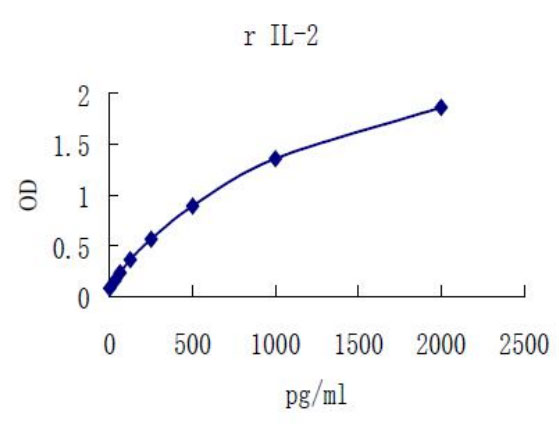Interleukin 2 (IL-2) is a pleiotropic cytokine produced primarily by mitogen- or antigen-activated T lymphocytes (1, 2). It plays a key role in promoting the clonal expansion of antigen-specific T cells. In addition, IL-2 has been shown to mediate multiple immune responses on a variety of cell types.
IL-2 has been found to stimulate growth and differentiation of B cells, NK cells, LAK cells, monocytes, and oligodendocytes. IL-2 is involved in treatment of cancers such as melanoma and renal cell cancer. It plays a key role in promoting the clonal expansion of antigen-specific T cells. In addition, IL-2 has also been shown to mediate multiple immune responses on a variety of cell types.
The sequence of rat IL-2 cDNA predicts a 155 amino acid (aa) residue precursor glycoprotein containing a 20 aa residue signal peptide that is cleaved to form the mature protein (3). At the amino acid sequence level, mature rat IL-2 is approximately 80% identical to mouse IL-2 (1-4).
The biological effects of IL-2 are mediated by specific cell surface receptor complexes. The functional high-affinity receptor for IL-2 is composed of three distinct polypeptide chains(5, 6).
IL-2 stimulates the proliferation of thymocytes; stimulates the proliferation and differentiation of activated B cells; promotes the growth, differentiation and cytocidal activity of monocytes; induces the growth of and cytokine production and cytolytic activity by natural killer cells; enhances the production of lymphocyte-activated killer (LAK) cells; and induces the proliferation and differentiation of oligodendrocytes (1, 2).
Goldsmith, M.A. and W.C. Greene (1994) in The Cytokine Handbook, 2nd ed., A. Thomson editor, Academic Press, New York, p. 57.
Hatakeyama, M. and T. Taniguchi (1990) in Peptide Growth Factors and Their Receptors I, Sporn, M.B. and A.B. Roberts eds., Springer-Verlag, New York, p. 523.
McKnight, A.J. et al. (1989) Immuno. Genetics 30:145.
Kashima, N. et al. (1985) Nature 313:401.
Kashima, N. et al. (1985) Nature 313:401.
Seigel, L.J. et al. (1984) Science 223:175.

